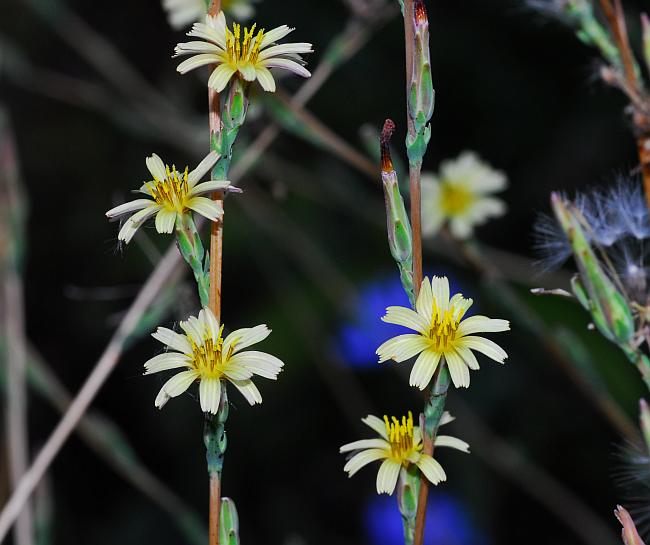Lactuca saligna L.
Willow-Leaved Lettuce

Introduced
CC = *
CW = 3
MOC = 44
© SRTurner
Lactuca saligna L.Willow-Leaved Lettuce | |
 |
Introduced CC = * CW = 3 MOC = 44 |
© SRTurner |
|
Family - Asteraceae/Cichorieae Habit - Annual or biennial forb with milky sap. Stem - Erect, to 1 m or more, glabrous, sometimes glaucous, light tan; latex white.
Leaves - Well developed along stem, to 15 cm long, narrow, linear and unlobed or narrowly elliptic-lanceolate in outline, sessile and clasping, auriculate, glabrous or occasionally with short hairs along abaxial midvein.
Inflorescences - Narrow, spikelike panicles with 30-100 or more heads.
Heads - Involucres cylindrical, 7-9 mm long, with about 17 involucral bracts. Receptacle naked.
Flowers - Ligulate florets 11-14, pale yellow, sometimes with a bluish- or purplish-tinged undersurface. Pappus of 4-6 mm bristles.
Fruits - Achenes with the body 3.0-3.5 mm long, about 1.0-1.5 mm wide, greenish brown to dark gray, flattened, with 5-7 conspicuous nerves or ridges on each face, tapered abruptly to a slender beak 1.5-2.0 times as long as the body.
Flowering - July - October. Habitat - Streambanks, bottomland forest openings, margins of glades, disturbed portions of bottomland prairies, ditches, levees, fields, gardens, pastures, railroads, roadsides, open, disturbed areas. Origin - Native to Eurasia Lookalikes - Broadly, L. serriola, L. canadensis. Other info. - This distinctive introduced lettuce occurs across Missouri, though it is scattered and somewhat uncommon. There are two main ranges in the continental U.S., one in a band extending from eastern Kansas eastward through Pennsylvania, the other in areas approaching the west coast. The plant is recognized by its very narrow leaves, which exude milky white sap if broken, and yellow ligulate flower heads. Photographs taken in Labadie, Franklin County, MO, 8-1-2012 (SRTurner). |